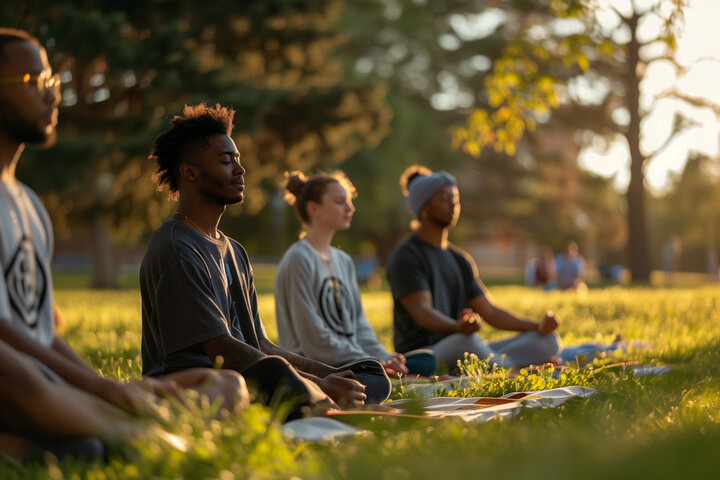How and Where to Learn Mindfulness: A Practical Guide with Resources, Research, and Support
In today’s fast-paced world, more and more people are discovering the benefits of mindfulness—a practice rooted in ancient traditions and supported by modern science. But what is mindfulness exactly, how can you learn it, and where can you find trusted training and support?
Whether you’re curious about mindfulness for personal wellbeing or considering a deeper path of training, this guide will help you get started with evidence-based insights, free practices, and reliable organisations.
What Is Mindfulness?
Mindfulness is the practice of paying attention, on purpose, in the present moment, and without judgment. This simple idea has roots in Buddhist meditation but has been adapted into modern psychology and healthcare.
Jon Kabat-Zinn, who developed the Mindfulness-Based Stress Reduction (MBSR) programme, defines it as:
“Awareness that arises through paying attention, on purpose, in the present moment, non-judgmentally.”
– Kabat-Zinn, 2003
Mindfulness helps us respond to life with greater clarity and kindness, rather than reacting on autopilot. It’s been shown to reduce stress, anxiety, depression, and even physical pain (Khoury et al., 2013).

How Do You Practise Mindfulness?
Mindfulness can be practiced formally—through meditation—or informally by bringing attention to everyday activities like eating, walking, or listening.
Some core practices include:
Breath Awareness
Body Scan Meditation
Mindful Movement
Loving-Kindness Meditation
These can be done sitting, lying down, or even while walking. Apps like Headspace and Insight Timer offer excellent guided meditations.
🌀 Try This: A Simple Breath Awareness Practice
Here’s a short practice to help you get started:
Sit comfortably. Close your eyes or soften your gaze.
Bring your attention to your breath—feeling the air move in and out of your nostrils or the rise and fall of your chest.
If your mind wanders, gently notice it, and return your focus to your breath.
Stay with this for a few minutes.
You can also listen to this guided 5-minute breath awareness meditation.

Evidence-Based Approaches to Learning Mindfulness
Many people start their mindfulness journey through structured programmes backed by research. Here are some of the most respected:
1. MBSR – Mindfulness-Based Stress Reduction
Developed at the University of Massachusetts Medical School by Jon Kabat-Zinn, MBSR is an 8-week course combining mindfulness meditation and yoga.
Research:
JAMA Internal Medicine, 2014: MBSR improves anxiety, depression, and pain.
Centre for Mindfulness at Brown University offers training and teacher certification.
2. MBCT – Mindfulness-Based Cognitive Therapy
Originally developed to prevent relapse in depression, MBCT blends mindfulness with cognitive therapy techniques.
Research:
Segal, Williams, Teasdale and Oxford’s Oxford Mindfulness Foundation are global leaders.
The Lancet, 2015: MBCT is as effective as antidepressants in preventing depression relapse.
3. Mindfulness Now
A UK-based integrative approach that combines MBSR and MBCT with flexibility for modern life. Offered by The UK College of Mindfulness Meditation, it’s ideal for both personal development and professional training.
Learn more:
Where Can I Learn Mindfulness?
Find a Teacher Near You
Learning from a qualified teacher can be deeply supportive. The Mindfulness Teachers Association (MTA) is the UK’s primary professional body for accredited mindfulness teachers and organisations.
Click here for Best Practice Guidelines for Mindfulness Teachers and Training Organisations
Why choose an MTA-registered teacher?
Trusted quality
Evidence-based training
Adherence to ethical standards
Trauma-aware practices
Explore:
The MTA only lists organisations that meet rigorous standards of training and delivery—such as the UK College of Mindfulness Meditation and others that follow NICE and NHS-aligned guidelines.
🌐 Online Courses and Resources
If you’re not ready for in-person sessions, here are some well-respected options:
Quick Tips to Start Your Mindfulness Journey
Start small – even 3 minutes a day can make a difference.
Use a guided meditation – this reduces the overwhelm of “doing it wrong.”
Be kind to yourself – it’s natural for your mind to wander.
Create a routine – tie practice to a daily activity like morning coffee.
Find community – a group or teacher adds encouragement and support.
From Learning to Teaching?
If you’re already practicing mindfulness and want to go deeper, consider teacher training. Programmes like Mindfulness Now Teacher Training offer a supervised and accredited path, culminating in optional MTA registration.
“Joining the MTA demonstrates your commitment to professional standards, trauma-informed care, and continuing development.”
– Mindfulness Teachers Association




